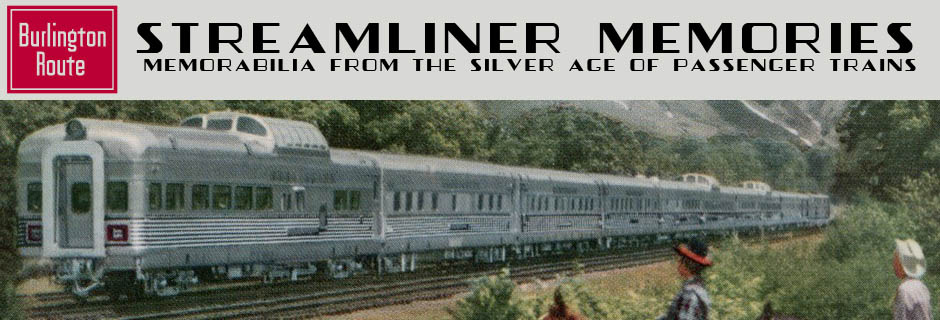In 1862, the first steam locomotive in Minnesota arrived in St. Paul, then a bustling frontier town of about 12,000 people. But the locomotive didn’t arrive by rail. Thanks to St. Anthony Falls, which were 16 to 20 feet high, St. Paul was the head of navigation on the Mississippi River, so the first locomotive was delivered by steamboat. That locomotive, the William Crooks, helped build the St. Paul & Pacific Railroad, the forerunner of the Great Northern.
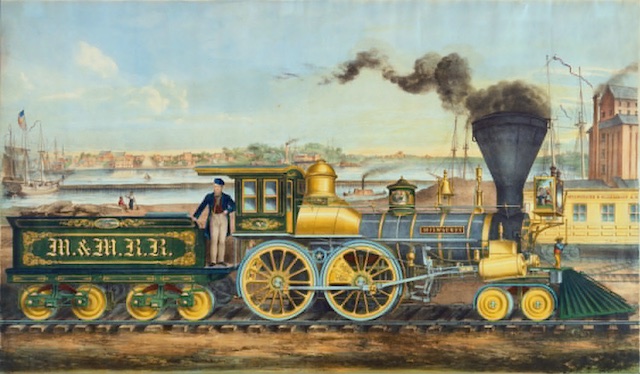
The Milwaukee & Mississippi was one of the predecessors of the Milwaukee & St. Paul. This locomotive was pictured in about 1860, the year before the M&M went bankrupt. It was absorbed by the Milwaukee & St. Paul in 1863. Click image for a larger view.
The first railroad to connect St. Paul with the rest of the nation’s rail network was the Milwaukee & St. Paul, which completed rails between its two namesake cities in 1872. Also in 1872, it purchased the St. Paul & Chicago Railroad, giving it a connection to the latter city. By June, 1874, it had added the word “Chicago” to its name. In that year, Chicago, Milwaukee & St. Paul passenger trains took about 22 hours to travel between Chicago and St. Paul, for average speeds of about 18 miles per hour.
The train was even slower getting to Minneapolis. In 1872, Minneapolis was smaller than St. Paul but growing faster as flour mills harnessed the power of St. Anthony Falls to grind the wheat that was grown in the Red River Valley. Bridging the Mississippi in the vicinity of the falls was treacherous, so initially trains had to travel some 10 miles south to Mississippi Bridge 15, cross the river and then go back north, crossing the Minnesota River along the way, before arriving in downtown Minneapolis. Because the bridges were often open for river traffic, the timetable allowed 85 minutes for this trip of about 20 miles (14 mph), but according to bridge and railfan John Weeks the trips could sometimes take half a day.
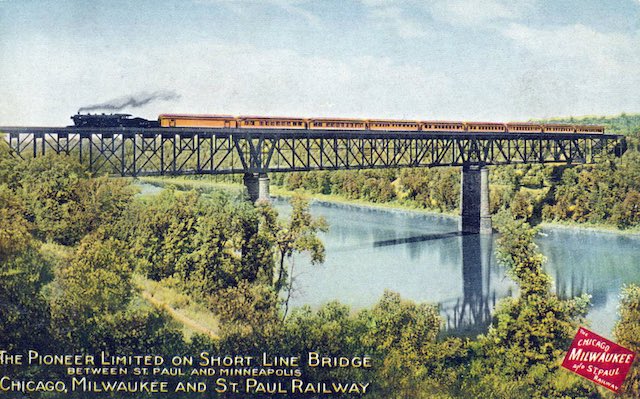
The 1898 Pioneer Limited crosses the 1880 Short Line Bridge between St. Paul and Minneapolis. Click image for a larger view.
In 1880, the St. Paul road built a new bridge between St. Paul and Minneapolis that greatly reduced this trip, leading people to call it the Short Line Bridge. Travel time for the fastest train from Chicago to Minneapolis fell to 17 hours.
In September 1888, the railroad introduced the first train west of Chicago with electric lighting. The overnight train had no name and was known in the timetables as trains 1 & 4, the “Vestibuled train.” The train took 14 hours and 40 minutes to get from Chicago to St. Paul. In November of 1892, the railroad cut this down to 14 hours exactly — 30 miles per hour — where it remained for seven years.
In 1898, the St. Paul road purchased all-new equipment for its premiere train, trains 1 & 4. After holding a contest to name the train, it selected Pioneer Limited, making it the first named train on the railroad. It was proud enough of the new equipment that it showed it off to people in cities and towns all along the line, proclaiming it to be “the most beautiful train in the world.”
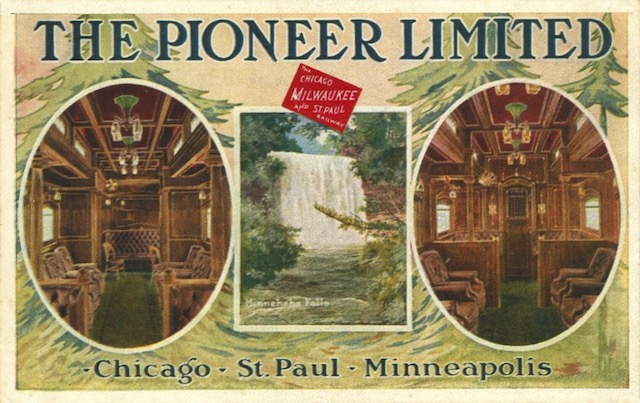
This postcard emphasizes the beauty and craftsmanship on the train’s library-buffet car. Click image to download a 261-KB PDF of this postcard.
The two trains of ten cars were made by Barney & Smith of Dayton, Ohio. The manufacturer modestly declared them to be “the finest specimens of car building work ever put into service.”
Each train included a baggage car, smoker-library-buffet, compartment sleeping car, two regular sleeping cars (with open sections), diner, parlor car, two day coaches, and a reclining chair car. The cars were four inches wider and eight inches taller than the ones they replaced, making them some of the largest ever built up to that time.
The library car interior was primarily finished in St. Jago mahogany, but also included tulip tree, amaranth, primavera, saffron, olive, cocobolo, white holly, and English oak. One of the sleeping cars included seven compartments and two drawing rooms finished in St. Jago mahogany, padouk, and Circassian walnut. The reclining chair cars were also finished with mahogany. Even the vestibules were finished in mahogany. Exteriors were painted yellow with gold trim.
“The Pioneer Limited certainly presented a very beautiful exterior appearance,” the Waterton Republican observed after the train passed through its town. An inspection of both inside and out convinced the paper that it “well bears out what has been claimed for it — that it is the handsomest on any railroad of the world. Every car has been built with the view to combine elegance and comfort, and the result is all that the traveler could wish for.”
The train began operating on May 22 following the same 14-hour schedule as before. Now, however, the timetables identified it as “the Pioneer Limited–Solid Electric Lighted Vestibule Train.”
In a foreshadowing of the Milwaukee’s first streamliners, the train was initially hauled by “A-1” class 4-4-2 locomotives built by Baldwin in 1896. They had 78″ drivers and produced only about 14,200 pounds of tractive effort.
In 1904, the railroad managed to reduce the time required to go from Minneapolis to Chicago to just 13 hours, or 32 miles per hour. Though the westbound trip was 13-1/2 hours, this was still a lot of progress since the 21-hour trips of 1874 or the 17-hour trips of 1880. However, that seemed to be the most the St. Paul road could squeeze out of the timetable as times hovered around 13 to 13-1/2 hours for the next two decades.
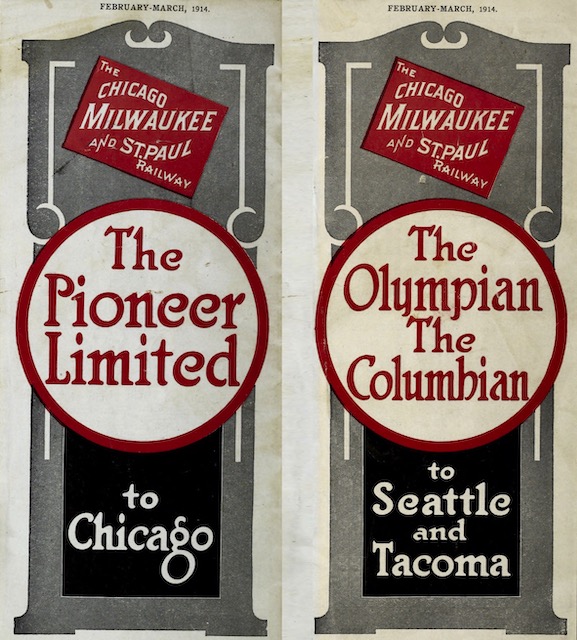 Click image to download a 12.0-MB PDF of this 16-page timetable, which I’ve reformatted somewhat from the version posted on archive.org.
Click image to download a 12.0-MB PDF of this 16-page timetable, which I’ve reformatted somewhat from the version posted on archive.org.
In 1914, the year in which the St. Paul road completely re-equipped the Pioneer Limited with all-steel passenger cars, the train took 13 hours and 5 minutes to go from Minneapolis to Chicago and 13 hours and 40 minutes to go from Chicago to Minneapolis. A dozen years later, northbound times had slipped to 13 hours and 25 minutes while southbound had improved only slightly to 12 hours and 35 minutes or 33.5 miles per hour.
Sometime around 1930 — I don’t have an exact date because my Official Guide and timetable collection is incomplete — the time for the Pioneer Limited would drop to around 11 hours. With streamlining, it would fall to around 9 to 10 hours. While the Hiawathas went from Chicago to Minneapolis in just 7 hours, night trains didn’t need to go as fast because most people preferred a good night’s sleep over a pre-dawn arrival at their destination city.
